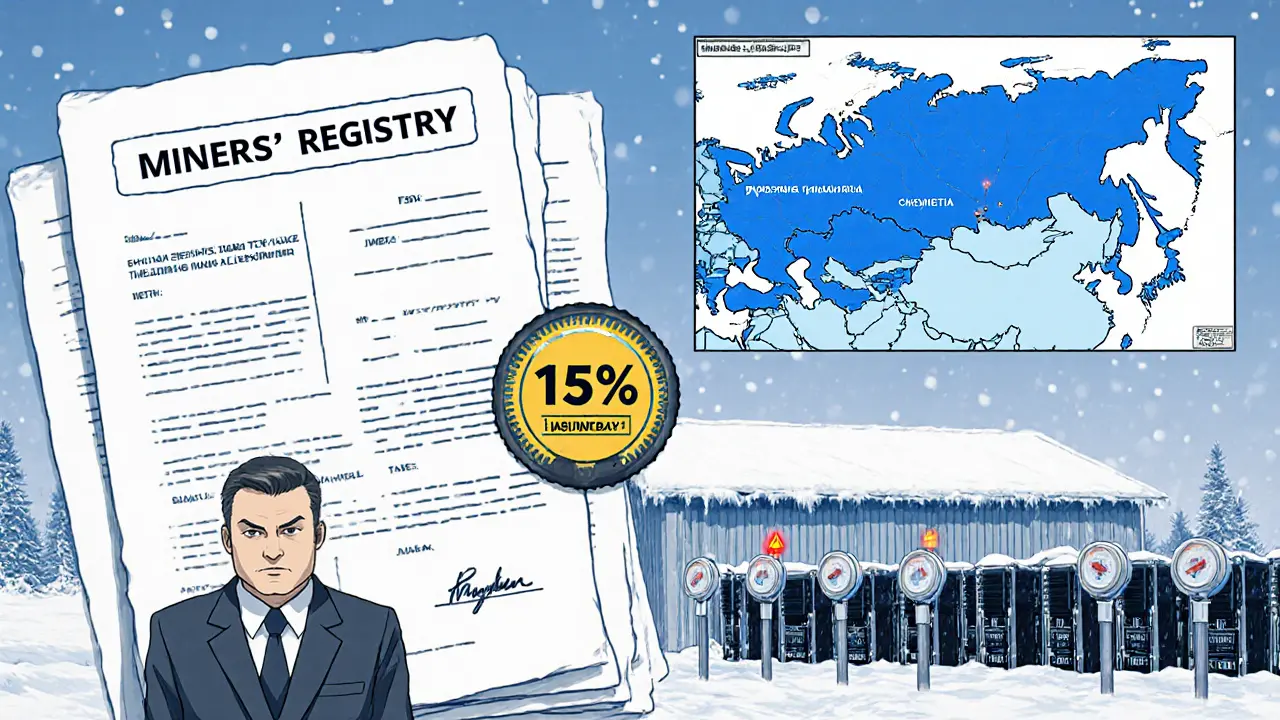Russia Mining Compliance Calculator
Compliance Check Tool
When it comes to cryptocurrency mining the process of validating blockchain transactions using computer hardware in Russia the Russian Federation, a country spanning Eastern Europe and Northern Asia, the legal landscape has shifted dramatically over the past year. If you’re thinking about setting up rigs, you’ll need to navigate new rules on registration, taxes, and regional bans that started rolling out on January 1 2025.
Why the rules changed in 2024‑2025
Until late 2023, Russian authorities treated crypto mining as a gray‑area activity, often cracking down on illegal farms. In August and October 2024 the government passed a comprehensive mining law that turned the sector from “illegal” to “regulated but controlled.” President Vladimir Putin’s administration wanted two things: tap into the economic upside of mining and protect the national power grid, which was already under strain from harsh winters.
The law introduced three core mechanisms:
- Mining equipment can be remotely shut off during peak demand, placing miners in the lowest‑priority "fourth category" of consumers.
- Heavy fines - from 200,000 rubles up to 2 million rubles (about $25,500) - target unregistered operations.
- A state‑run miners' registry a database that tags and tracks every imported mining device that lets officials monitor electricity use in real time.
These moves were meant to give the state a safety valve while still allowing legitimate operators to profit.
Registration, taxation and the 15% Bitcoin mining tax
If you run a business or even a small farm that consumes more than 6,000 kWh per month, you must register with the national miners' registry. The registration process is handled through the Federal Tax Service Russia's main tax authority. Failure to register means you are automatically subject to the highest fines.
On the tax side, the government introduced a flat 15% crypto mining tax on Bitcoin mining profits in November 2024. The tax applies to both corporate and individual miners, and it is collected alongside the standard income tax. Reporting is done quarterly via the same portal used for regular business taxes.
One practical tip: keep a separate ledger for electricity costs, hardware depreciation, and mining rewards. The tax office can request this data during audits, and clear records can shave weeks off a potential audit timeline.
Geographic bans and seasonal limits
Russia’s most visible restriction is a patchwork of regional bans. As of January 1 2025, ten regions - including Dagestan, Ingushetia, Chechnya, the Donetsk and Lugansk People's Republics, and the occupied Zaporizhzhia and Kherson territories - have a total ban on mining that will stay in place until March 15 2031.
Three Siberian regions (Irkutsk, Buryatia and Zabaikalsky) face seasonal bans during winter peaks. Initially the ban ran from January 1 to March 15 2025, but the window expands each year and will eventually cover November 15 through March 15.
| Region | Restriction type | Effective dates |
|---|---|---|
| Dagestan | Full ban | 2025‑2031 |
| Ingushetia | Full ban | 2025‑2031 |
| Chechnya | Full ban | 2025‑2031 |
| Donetsk People’s Republic | Full ban | 2025‑2031 |
| Irkutsk | Seasonal | Nov‑Mar (expanding each year) |
| Buryatia | Seasonal | Nov‑Mar (expanding each year) |
| Zabaikalsky | Seasonal | Nov‑Mar (expanding each year) |
For miners, the practical impact is simple: locate your operation in a region without a ban, or be ready to shut down during the seasonal window. Many operators are moving east to the Ural federal district, where the grid is less stressed and the regulatory environment is more predictable.

Power‑grid priority and remote shutdown technology
The Russian energy ministry installed a remote‑disconnection system that can cut power to mining farms with a single command. Because miners are classified as fourth‑category consumers, the grid automatically switches them off before residential or hospital loads are affected.
This system works via smart meters that report real‑time consumption to a central control hub. If demand spikes, the hub sends a signal to the meter, which drops voltage to the mining rigs. The technology is similar to load‑shedding used in many countries, but the key difference is that it targets a specific industry.
What does this mean for you? Keep a backup generator or a battery storage system if you can afford it. Having an alternative power source not only protects revenue but also shows regulators that you’re taking responsible steps, which may result in lighter penalties if you’re ever flagged.
Compliance challenges and enforcement trends
Despite the law, compliance is still a work in progress. As of mid‑2025, only about 30 % of miners are registered with the Federal Tax Service, according to Deputy Minister of Finance Ivan Chebeskov a senior Russian official overseeing finance and taxation. The same source said another two‑thirds of the sector remains in the shadows.
Enforcement is tightening. The digital development ministry is considering raising the minimum fine from 200,000 rubles to 2 million rubles for repeat offenders. In practice, inspectors conduct on‑site audits, request equipment serial numbers, and cross‑check them against the miners' registry.
For legitimate operators, the best strategy is proactive compliance:
- Register every hardware unit as soon as it arrives.
- Submit quarterly electricity usage reports.
- Maintain a clear paper trail of mining rewards and conversion to fiat.
- Stay informed about regional policy updates - they can change with each winter.
Following these steps reduces the risk of sudden shutdowns and can even make you eligible for local subsidies in regions that are still encouraging mining to boost the economy.

Step‑by‑step checklist for starting a legal mining operation in Russia (2025)
- Choose a location: Verify the region’s restriction status. Avoid full‑ban areas and check seasonal windows.
- Calculate power needs: Ensure consumption stays below 6,000 kWh/month if you want to skip registration. Otherwise, budget for registration fees and ongoing tax compliance.
- Register hardware: Use the online miners' registry portal. Provide serial numbers, model, and import documentation.
- Open a tax account: Register with the Federal Tax Service, obtain a tax ID for the mining business, and set up quarterly reporting.
- Implement monitoring: Install smart meters that integrate with the national grid system. This avoids unexpected remote shutdowns.
- Plan for taxes: Allocate at least 15 % of mining profits for the Bitcoin mining tax, plus standard income tax rates.
- Prepare backup power: Battery banks or generators can keep you running during forced outages, preserving uptime and revenue.
- Stay updated: Follow announcements from the Ministry of Energy and the Ministry of Digital Development for any rule changes.
By ticking each box, you’ll be operating within the law and can focus on maximizing hash rate rather than worrying about enforcement raids.
Future outlook - what’s next for crypto mining in Russia?
The current framework runs through March 2031, giving miners a long runway of certainty. However, the government retains the right to tighten or relax rules based on energy availability and economic needs. Some analysts predict that once the power grid stabilizes, the remote‑shutoff feature could be limited to only emergency situations, making mining more reliable.
Investment advice from local experts suggests allocating no more than 5 % of a diversified portfolio to mining, given the regulatory risk. Diversifying across regions (e.g., moving rigs between the Ural district and Siberia during seasonal bans) can also smooth revenue streams.
In short, Russia offers a unique blend of high‑energy costs, abundant cold climate (good for hardware cooling), and a detailed legal structure. If you respect the rules, the market still holds attractive profit potential.
Do I need to register my mining hardware if I use less than 6,000 kWh per month?
No. Small‑scale miners that stay under the 6,000 kWh threshold are exempt from the mandatory miners' registry, but they still must report any crypto‑related income on their personal tax return.
What are the penalties for operating without registration?
Fines start at 200,000 rubles and can rise to 2 million rubles for repeat violations. In extreme cases, authorities may seize equipment and suspend electricity supply.
How is the 15 % mining tax calculated?
The tax applies to net profits from Bitcoin mining after deducting electricity costs, hardware depreciation, and other allowable expenses. It is paid quarterly alongside the regular income tax filing.
Can I operate in a region with a seasonal ban?
You can, but you must shut down during the prohibited months. Many operators use automated scheduling to turn rigs off and on according to the seasonal calendar.
What should I do if the grid remotely disconnects my rigs?
First, verify the reason via the smart‑meter dashboard. If it’s a peak‑demand event, you can resume once the grid signals clearance. Having a backup generator can keep you running and reduce downtime.


5 Responses
Thinking about diving into crypto mining in Russia? Remember that every rule is a signal pointing to deeper opportunities 🌟. If you stay adaptable, you can turn restrictions into a strategic advantage 😎.
To keep things clean, register your equipment as soon as it arrives and keep a spreadsheet of power use, hardware serial numbers, and profit margins. The tax portal accepts CSV uploads, so a tidy file saves you weeks of paperwork.
One must, with a measured cadence, contemplate the ontological ramifications of imposing a state‑mandated fiduciary levy upon the digital ether, for such fiscal impositions are not merely regulatory artifacts, but rather, a manifestation of sovereign epistemology, a testament to the state's desire to codify the seemingly anarchic nature of cryptographic computation; consequently, the miner, in acquiescence, becomes both subject and instrument of a grander geopolitical narrative, a paradoxical dance wherein autonomy is choreographed by legislative decree, and profit is the fleeting encore that follows.
Sure, the grand philosophical dance is fascinating, but the practical takeaway? You still need to file that quarterly report, keep your smart‑meter logs, and pay the 15 % tax, otherwise the authorities will gladly cut the lights.
The first step in any legal mining venture in Russia is to verify the regional policy, because operating in a banned area guarantees a forced shutdown. Once you have a clear map, calculate whether your projected consumption will stay below the 6,000 kWh threshold; if it does, you can skip the mandatory registry, though you must still declare earnings on your personal tax return. If you anticipate higher usage, prepare for registration by gathering serial numbers, import paperwork, and a dedicated tax account. The Federal Tax Service portal, while bureaucratic, offers a step‑by‑step wizard that walks you through hardware entry, and it is advisable to complete this before the quarterly reporting deadline. Electricity costs dominate the profit equation, so invest in energy‑efficient ASICs and monitor your hash‑rate per watt ratio continuously. In winter months, especially in the Siberian regions of Irkutsk, Buryatia, and Zabaikalsky, expect seasonal bans that will expand each year, potentially covering up to half the calendar by 2030. To mitigate downtime, many operators install automated scheduling software that synchronizes with the grid’s outage notifications and powers rigs down promptly. A backup generator or a modular battery bank not only safeguards revenue but also signals to regulators that you are taking responsible measures, possibly softening any punitive response. The 15 % mining tax applies to net profits after deducting electricity, depreciation, and other allowable expenses, and it must be reported quarterly alongside standard income tax. Keeping meticulous ledgers-preferably digital spreadsheets that can be exported as CSV-simplifies audits and reduces the likelihood of costly fines. Speaking of fines, they range from 200 000 rubles for first‑time offenders up to 2 million rubles for repeat violations, and in extreme cases equipment can be seized. While the remote‑shutoff system can deactivate your rigs instantly during peak demand, the smart‑meter interface provides real‑time alerts that let you anticipate interruptions. Some regions in the Ural federal district have begun offering modest subsidies to compliant miners, so maintaining good standing can open up financial incentives. It's also wise to stay abreast of policy updates from the Ministry of Energy and the Ministry of Digital Development, as amendments can appear with little lead time. Diversifying your hardware portfolio across multiple locations-such as splitting rigs between the Urals and a cooler Siberian site-helps smooth revenue streams when seasonal bans rotate. In summary, a combination of geographic awareness, diligent registration, proactive tax planning, and robust power backup will position you for sustainable profitability in Russia's evolving crypto landscape.